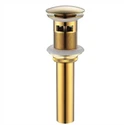When it comes to selecting a basin drain, one of the most crucial factors to consider is water pressure. As a trusted basin drain supplier, we understand the importance of making the right choice to ensure optimal performance and durability. In this blog post, we will guide you through the process of choosing a basin drain based on water pressure, providing you with valuable insights and practical tips.


Understanding Water Pressure
Before delving into the selection process, it's essential to have a basic understanding of water pressure. Water pressure refers to the force exerted by water as it flows through pipes and fixtures. It is typically measured in pounds per square inch (PSI) or bars. In residential settings, the average water pressure ranges from 40 to 80 PSI (2.7 to 5.5 bars). However, this can vary depending on factors such as the location, the age of the plumbing system, and the type of water supply.
Impact of Water Pressure on Basin Drains
Water pressure plays a significant role in the performance of basin drains. Insufficient water pressure can lead to slow drainage, clogging, and unpleasant odors. On the other hand, excessive water pressure can cause leaks, damage to the drain pipes, and premature wear and tear of the drain components. Therefore, it's crucial to choose a basin drain that can handle the specific water pressure in your plumbing system.
Types of Basin Drains and Their Suitability for Different Water Pressures
There are several types of basin drains available on the market, each with its own unique features and suitability for different water pressures. Let's take a closer look at some of the most common types:
1. Waste Basin Pop Up
The waste basin pop-up drain is a popular choice for residential bathrooms. It features a stopper that can be opened and closed by pressing down on it. This type of drain is suitable for low to medium water pressure systems. The pop-up mechanism helps to prevent water from splashing out of the basin while allowing for easy drainage. However, in high water pressure systems, the pop-up mechanism may be prone to malfunction or damage.
2. Pull Up Basin Waste
The pull-up basin waste drain is another common option. It consists of a rod that is attached to the stopper. By pulling up on the rod, the stopper can be lifted to allow water to drain. This type of drain is suitable for medium to high water pressure systems. The pull-up mechanism provides a more secure seal than the pop-up mechanism, making it less likely to leak or malfunction under high pressure.
3. Push Pull Basin Waste
The push-pull basin waste drain is a versatile option that can be used in both low and high water pressure systems. It features a stopper that can be opened and closed by pushing or pulling on a lever. This type of drain offers a convenient and easy-to-use solution for draining water from the basin. The push-pull mechanism provides a tight seal, preventing water from leaking out.
Factors to Consider When Choosing a Basin Drain Based on Water Pressure
In addition to the type of basin drain, there are several other factors to consider when choosing a basin drain based on water pressure. These include:
1. Pipe Size
The size of the drain pipe is an important consideration. Larger pipes can handle higher water pressure more effectively than smaller pipes. Therefore, if you have a high water pressure system, it's recommended to choose a basin drain with a larger pipe size.
2. Material
The material of the basin drain is also crucial. Different materials have different levels of durability and resistance to corrosion. For high water pressure systems, it's advisable to choose a basin drain made of high-quality materials such as stainless steel or brass. These materials are more resistant to pressure and corrosion, ensuring a longer lifespan for the drain.
3. Flow Rate
The flow rate of the basin drain refers to the amount of water that can pass through it per unit of time. A higher flow rate is desirable for high water pressure systems, as it allows for faster drainage. When choosing a basin drain, look for one with a high flow rate to ensure efficient water removal.
4. Installation
Proper installation is essential for the optimal performance of the basin drain. Make sure to follow the manufacturer's instructions carefully and use the appropriate tools and materials. Incorrect installation can lead to leaks, clogs, and other problems, especially in high water pressure systems.
Testing Your Water Pressure
If you're unsure about the water pressure in your plumbing system, you can test it using a water pressure gauge. These gauges are relatively inexpensive and can be purchased at most hardware stores. To test the water pressure, simply attach the gauge to an outdoor faucet or a hose bib. Turn on the water and read the pressure on the gauge. If the water pressure is outside the recommended range, you may need to consult a professional plumber to adjust it.
Conclusion
Choosing the right basin drain based on water pressure is essential for ensuring optimal performance and durability. By considering the type of drain, pipe size, material, flow rate, and installation, you can select a basin drain that is suitable for your specific plumbing system. As a basin drain supplier, we offer a wide range of high-quality basin drains that are designed to meet the needs of different water pressure systems. If you have any questions or need further assistance in choosing a basin drain, please don't hesitate to contact us. We look forward to working with you to find the perfect solution for your plumbing needs.
References
- "Plumbing Handbook" by Jack Donovan
- "Water Pressure: Understanding and Controlling It" by The Family Handyman
- Manufacturer's specifications and guidelines for basin drains





